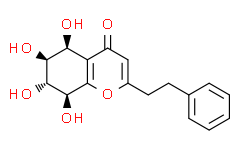6-EpiagarotetrolCAS# 2580359-99-3 |

Quality Control & MSDS
Package In Stock
Number of papers citing our products

| Cas No. | 2580359-99-3 | SDF | Download SDF |
| PubChem ID | N/A | Appearance | Powder |
| Formula | C17H18O6 | M.Wt | 318.32 |
| Type of Compound | N/A | Storage | Desiccate at -20°C |
| Solubility | Soluble in Chloroform,Dichloromethane,Ethyl Acetate,DMSO,Acetone,etc. | ||
| General tips | For obtaining a higher solubility , please warm the tube at 37 ℃ and shake it in the ultrasonic bath for a while.Stock solution can be stored below -20℃ for several months. We recommend that you prepare and use the solution on the same day. However, if the test schedule requires, the stock solutions can be prepared in advance, and the stock solution must be sealed and stored below -20℃. In general, the stock solution can be kept for several months. Before use, we recommend that you leave the vial at room temperature for at least an hour before opening it. |
||
| About Packaging | 1. The packaging of the product may be reversed during transportation, cause the high purity compounds to adhere to the neck or cap of the vial.Take the vail out of its packaging and shake gently until the compounds fall to the bottom of the vial. 2. For liquid products, please centrifuge at 500xg to gather the liquid to the bottom of the vial. 3. Try to avoid loss or contamination during the experiment. |
||
| Shipping Condition | Packaging according to customer requirements(5mg, 10mg, 20mg and more). Ship via FedEx, DHL, UPS, EMS or other couriers with RT, or blue ice upon request. | ||

6-Epiagarotetrol Dilution Calculator

6-Epiagarotetrol Molarity Calculator
| 1 mg | 5 mg | 10 mg | 20 mg | 25 mg | |
| 1 mM | 3.1415 mL | 15.7075 mL | 31.4149 mL | 62.8299 mL | 78.5373 mL |
| 5 mM | 0.6283 mL | 3.1415 mL | 6.283 mL | 12.566 mL | 15.7075 mL |
| 10 mM | 0.3141 mL | 1.5707 mL | 3.1415 mL | 6.283 mL | 7.8537 mL |
| 50 mM | 0.0628 mL | 0.3141 mL | 0.6283 mL | 1.2566 mL | 1.5707 mL |
| 100 mM | 0.0314 mL | 0.1571 mL | 0.3141 mL | 0.6283 mL | 0.7854 mL |
| * Note: If you are in the process of experiment, it's necessary to make the dilution ratios of the samples. The dilution data above is only for reference. Normally, it's can get a better solubility within lower of Concentrations. | |||||

Calcutta University

University of Minnesota

University of Maryland School of Medicine

University of Illinois at Chicago

The Ohio State University

University of Zurich

Harvard University

Colorado State University

Auburn University

Yale University

Worcester Polytechnic Institute

Washington State University

Stanford University

University of Leipzig

Universidade da Beira Interior

The Institute of Cancer Research

Heidelberg University

University of Amsterdam

University of Auckland

TsingHua University

The University of Michigan

Miami University

DRURY University

Jilin University

Fudan University

Wuhan University

Sun Yat-sen University

Universite de Paris

Deemed University

Auckland University

The University of Tokyo

Korea University
- (6S,7S,8S)-5,6,7,8-Tetrahydro-6,7,8-trihydroxy-2-(2-phenylethyl)-4H-1-benzopyran-4-one
Catalog No.:BCX0841
CAS No.:2803559-82-0
- Aquilarone C
Catalog No.:BCX0840
CAS No.:1404479-46-4
- 2'-Hydroxylisoagarotetrol
Catalog No.:BCX0839
CAS No.:104926-77-4
- 4H-xanthalongin
Catalog No.:BCX0838
CAS No.:72843-22-2
- 8-epi-helenalin
Catalog No.:BCX0837
CAS No.:97643-91-9
- 4'-Methoxyisoagarotetrol
Catalog No.:BCX0836
CAS No.:104901-10-2
- 6''-O-acetyl-saikosaponin B2
Catalog No.:BCX0835
CAS No.:104121-82-6
- (S)-Goitrin
Catalog No.:BCX0834
CAS No.:500-12-9
- Aquilarone B
Catalog No.:BCX0833
CAS No.:1404479-45-3
- 6''-O-Acetyldaidzin
Catalog No.:BCX0832
CAS No.:71385-83-6
- Artemisitene
Catalog No.:BCX0831
CAS No.:101020-89-7
- Paeonoside
Catalog No.:BCX0830
CAS No.:20309-70-0
- Arteether
Catalog No.:BCX0843
CAS No.:75887-54-6
- 2'-Hydroxylagarotetrol
Catalog No.:BCX0844
CAS No.:135308-83-7
- Triptonoterpene
Catalog No.:BCX0845
CAS No.:99694-87-8
- 2,3-Dihydro-3,5-dihydroxy-6-methyl-4(H)-pyran-4-one
Catalog No.:BCX0846
CAS No.:28564-83-2
- Annatto
Catalog No.:BCX0847
CAS No.:1393-63-1
- 6,7-Dihydroxy-2-(2-phenylethyl)-5,6,7,8-tetrahydrochromone
Catalog No.:BCX0848
CAS No.:626236-07-5
- Pseudoginsenoside Rg3(E)
Catalog No.:BCX0849
CAS No.:1012886-99-5
- Gymnoside I
Catalog No.:BCX0850
CAS No.:899430-01-4
- Aloinoside B
Catalog No.:BCX0851
CAS No.:11006-91-0
- Tomentosin
Catalog No.:BCX0852
CAS No.:33649-15-9
- Aloinoside A
Catalog No.:BCX0853
CAS No.:56645-88-6
- Okicamelliaside
Catalog No.:BCX0854
CAS No.:949148-45-2
Neuroprotective compounds from the resinous heartwood of Aquilaria sinensis.[Pubmed:33152579]
Phytochemistry. 2021 Jan;181:112554.
Six undescribed compounds, including three sesquiterpenoids [(4S,5S,7S,8S,11R)-7-hydroxyguai-1(10)-en-8,12-olide, aquilarisinone, and 2Z,7(13),9E-humulatrien-12-ol-5-one], one diphenylpentanone [1-(2-hydroxyphenyl)-5-phenylpentan-3-one], and two 2-(2-phenylethyl)chromones (6-Epiagarotetrol and triepoxyhexahydrochromone A), along with 15 known compounds, were isolated from the resinous heartwood of Aquilaria sinensis (Thymelaeaceae). Their structures were determined by mass (MS) and nuclear magnetic resonance (NMR) spectroscopic data. The absolute configuration of (4S,5S,7S,8S,11R)-7-hydroxyguai-1(10)-en-8,12-olide was confirmed by X-ray diffraction analysis, and the configurations of (4S,7S,8S,10R,11R)-7,10-epoxyguai-1(5)-en-8,12-olide, aquilarisinone, 6-Epiagarotetrol, and triepoxyhexahydrochromone A were confirmed by electronic circular dichroism (ECD) calculations. The neuroprotective activities of the compounds were evaluated using models of BACE1 inhibition and PC12 cells with corticosterone- and 1-methyl-4-phenylpyridine ion (MPP(+))-induced damage. At concentrations of 1, 2, and 5 muM, triepoxyhexahydrochromone A, (+)-(7R,10R)-selina-4,11(13)-diene-12,15-dial, (-)-(5R,7R,10R)-12,15-dioxo-alpha-selinene, and (+)-(1R,4S,5R)-1beta-hydroxyeremophila-7(11),9-dien-8-one exerted significant protective effects (p < 0.01) on PC12 cell injury induced by corticosterone, while triepoxyhexahydrochromone A and (-)-(5R,7R,10R)-12,15-dioxo-alpha-selinene exerted significant protective effects (p < 0.01) on MPP(+)-induced PC12 cell injury at concentrations of 1, 2, and 5 muM. No compounds produced significant inhibitory effects on BACE1, with inhibition rates of less than 20% observed at a concentration of 20 muM.


